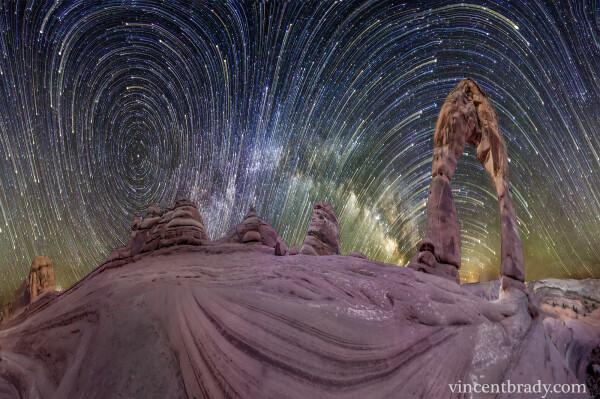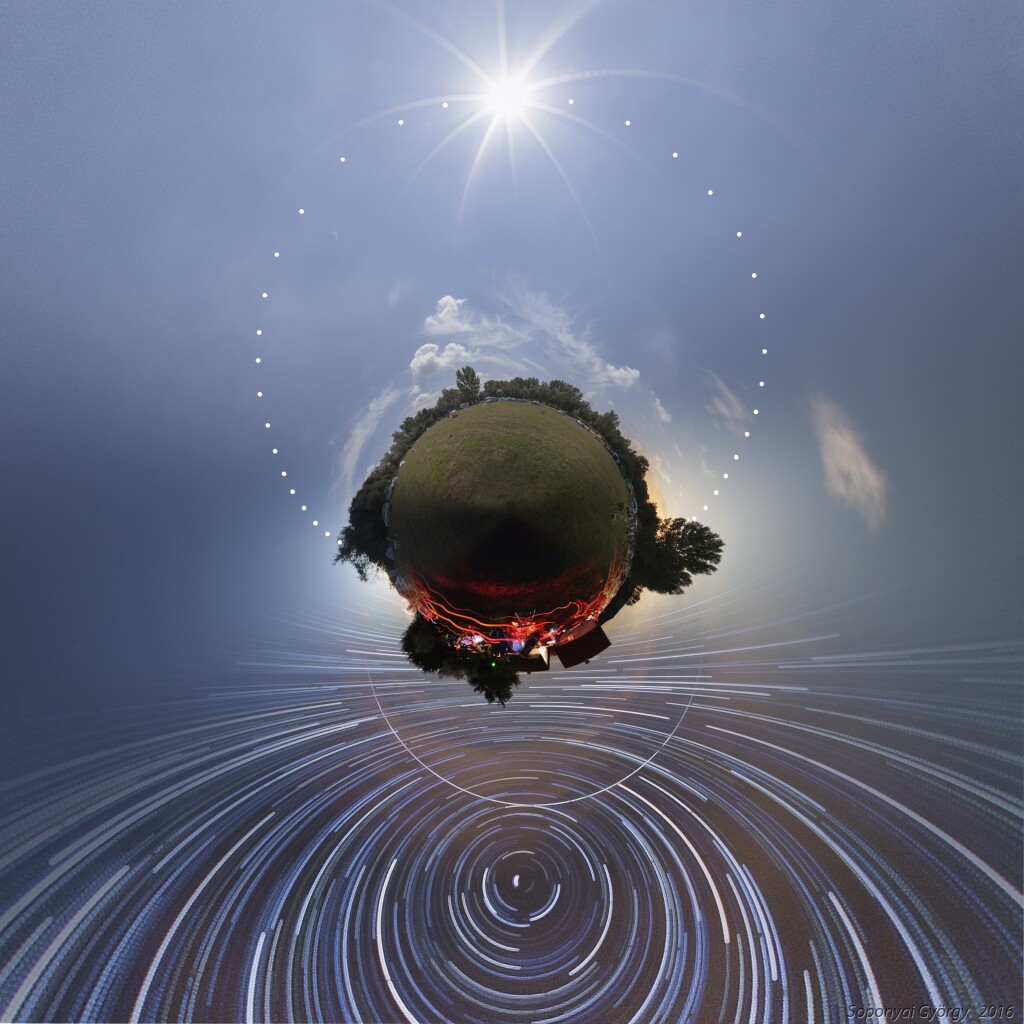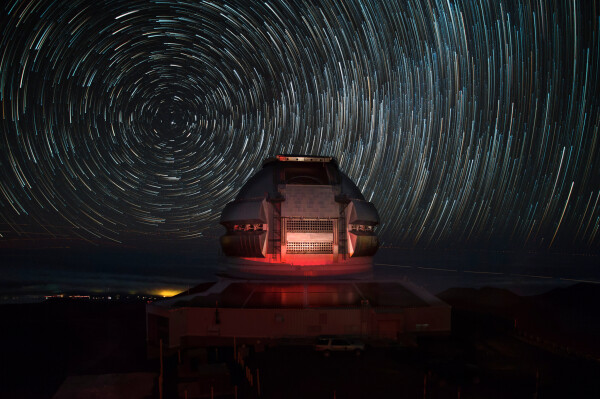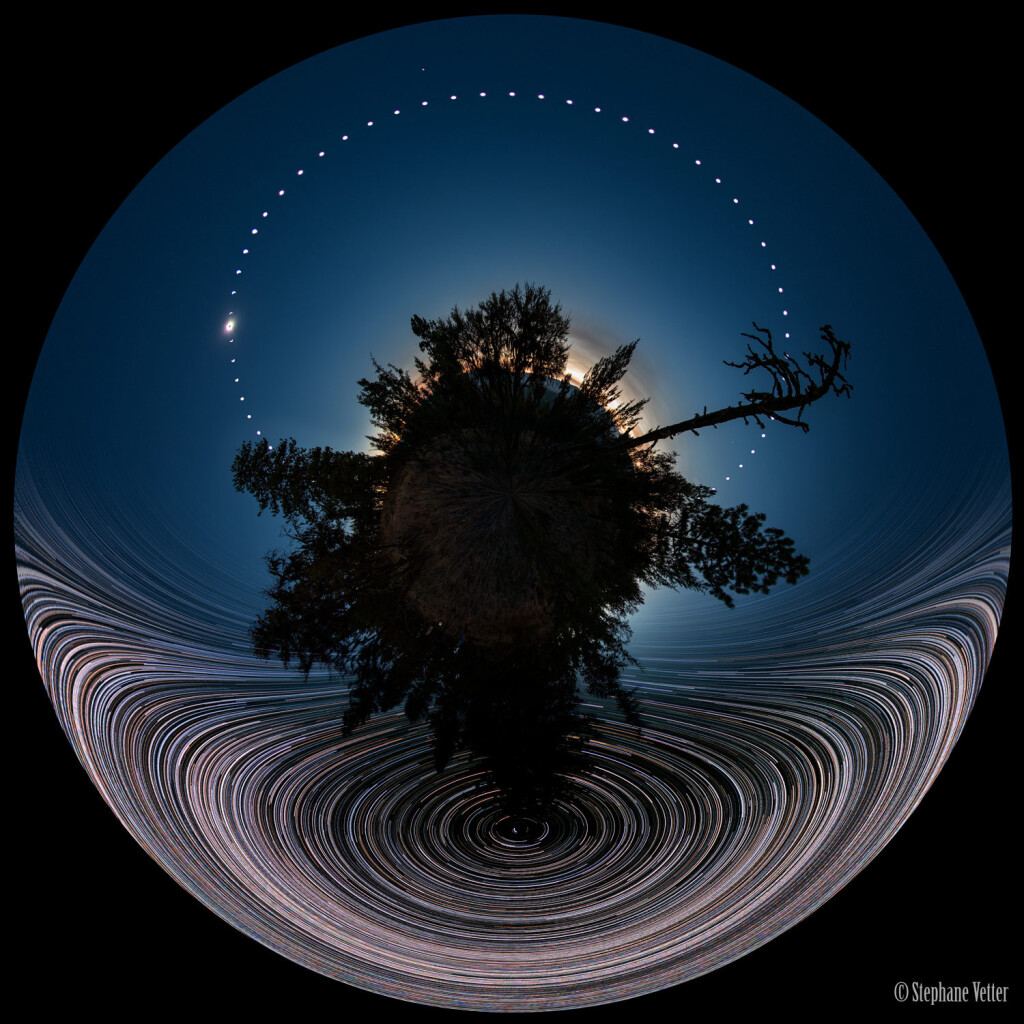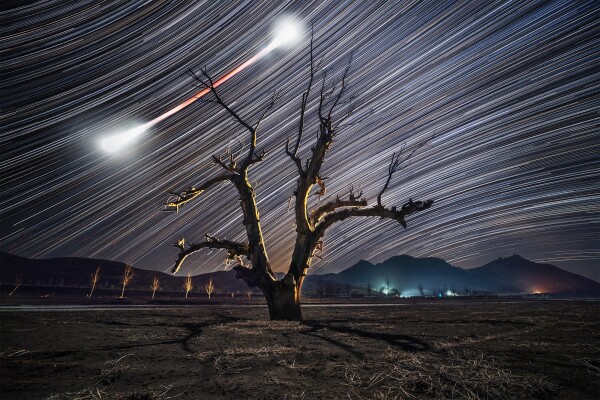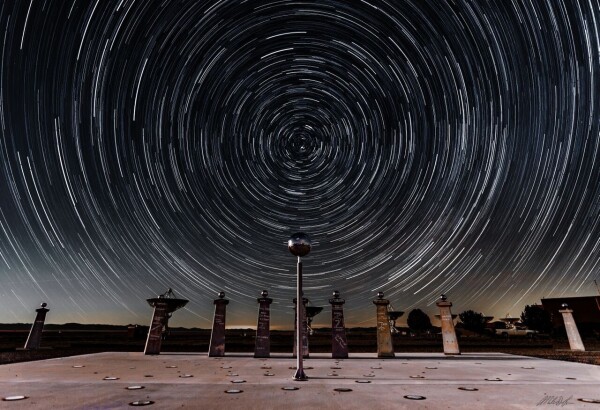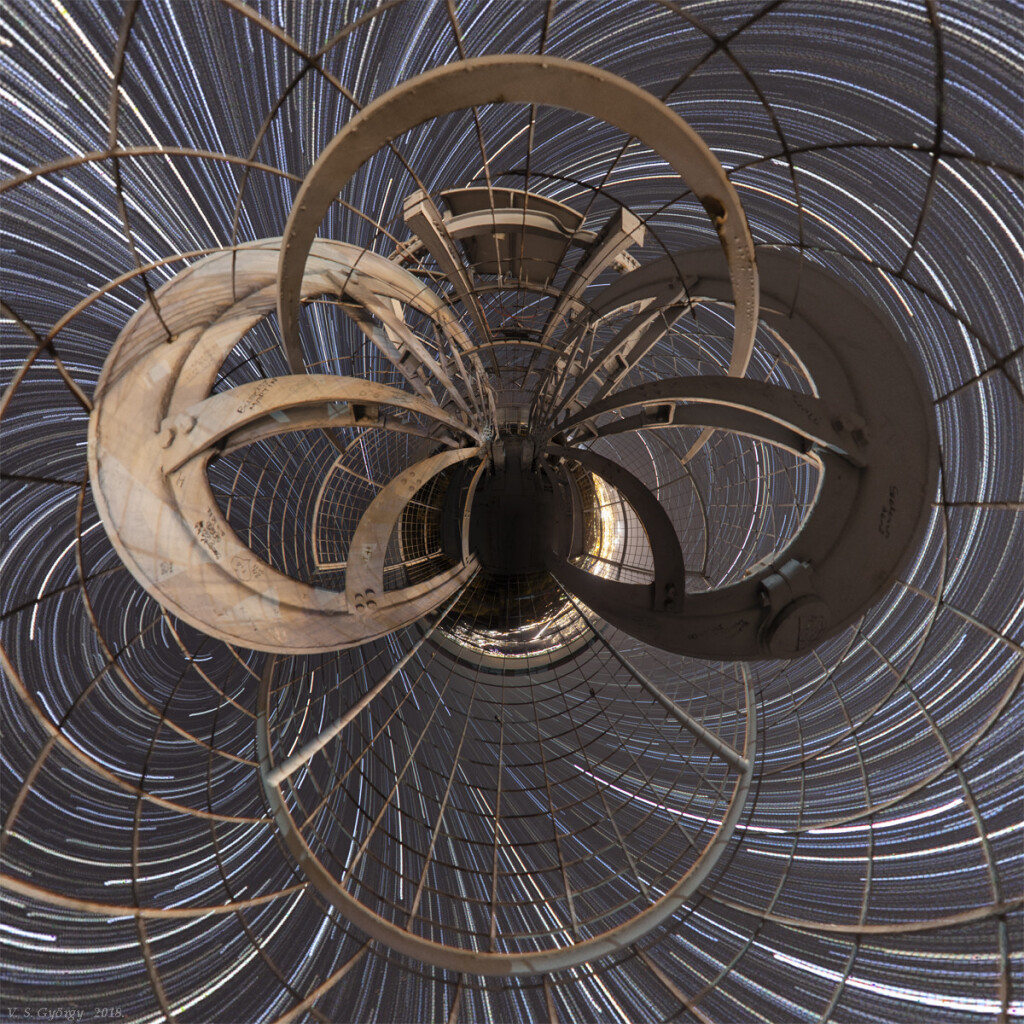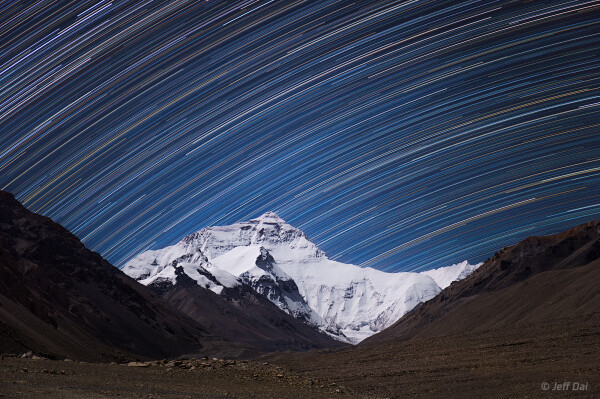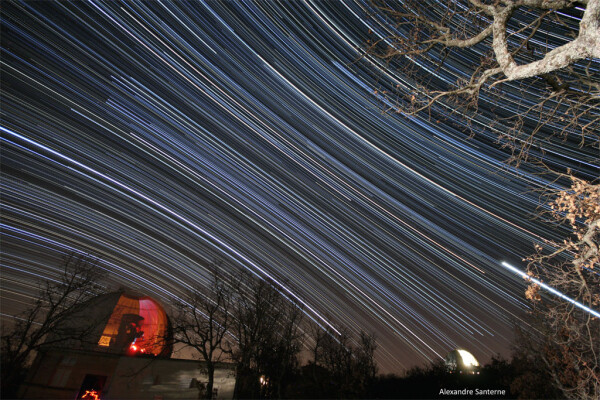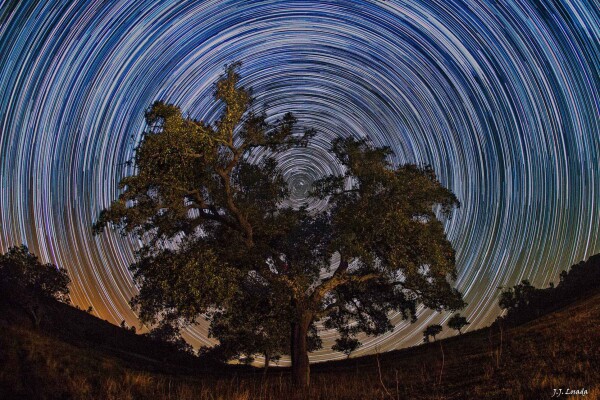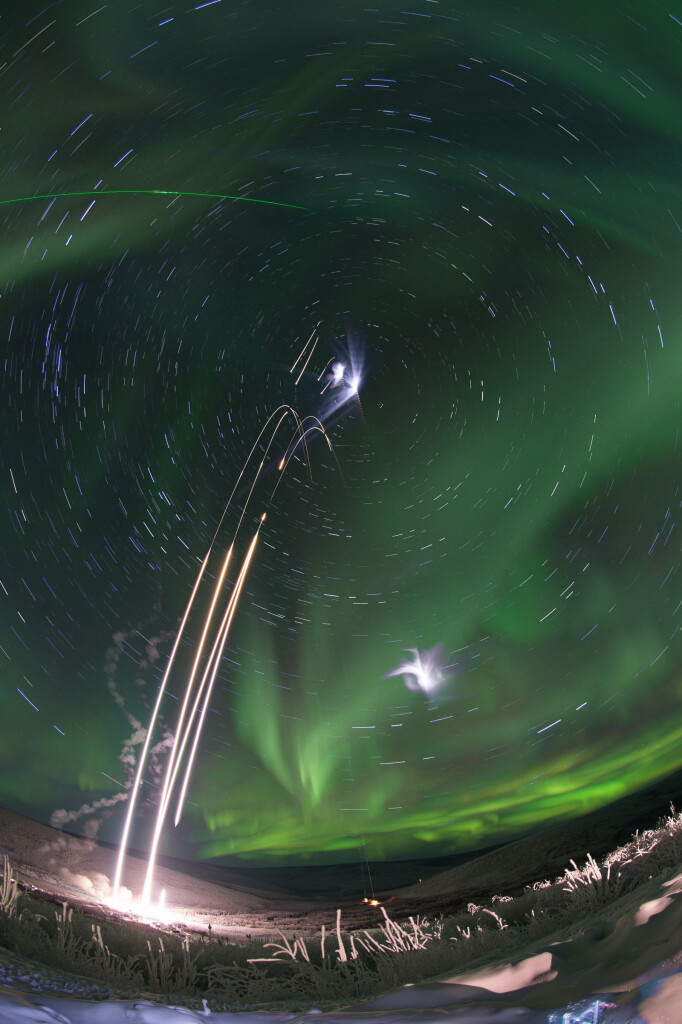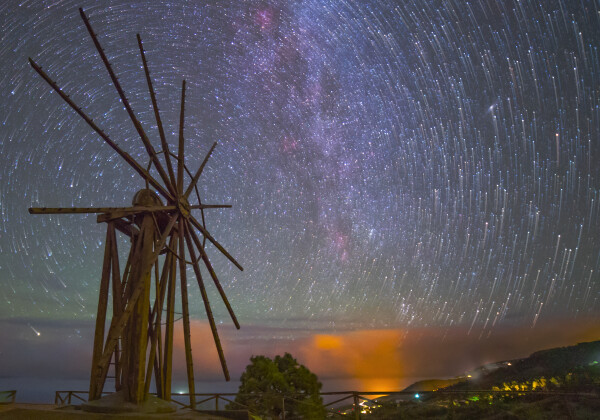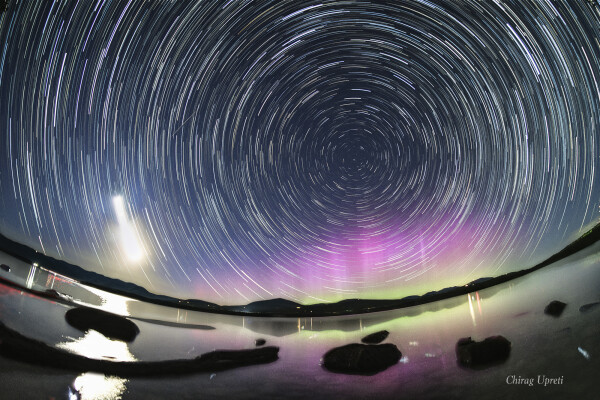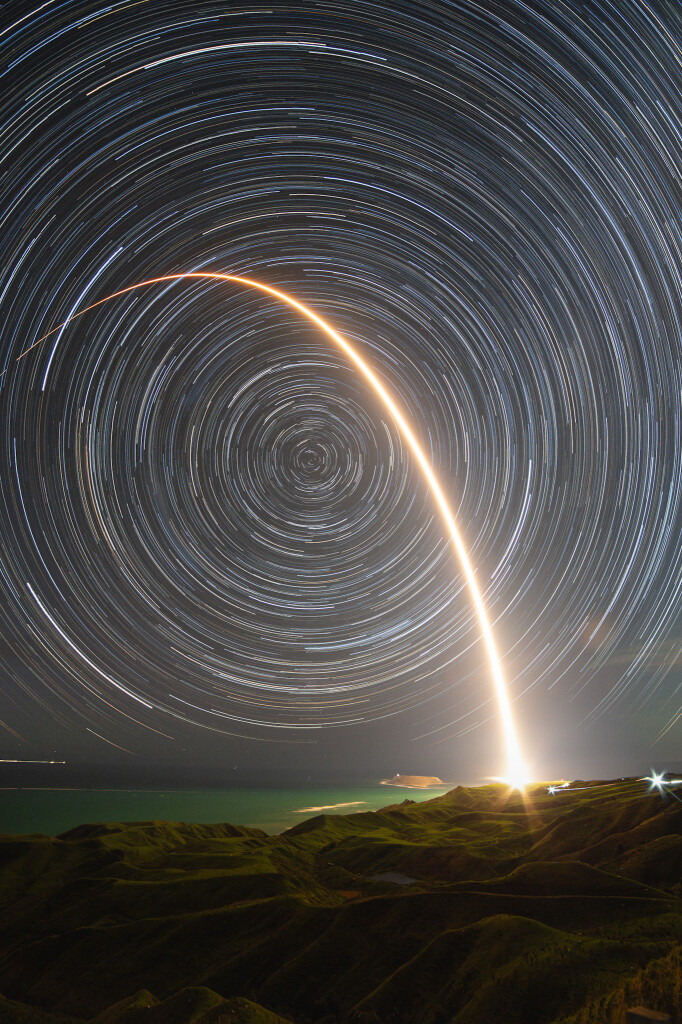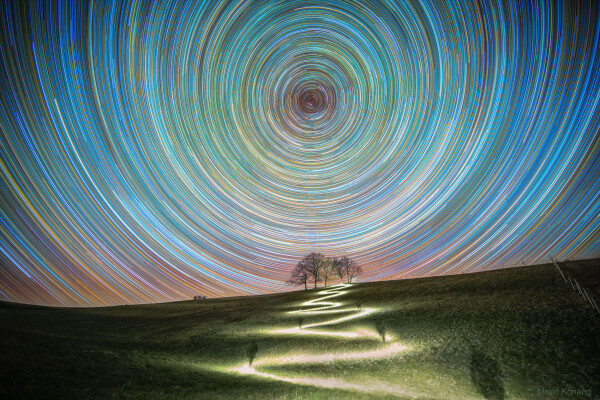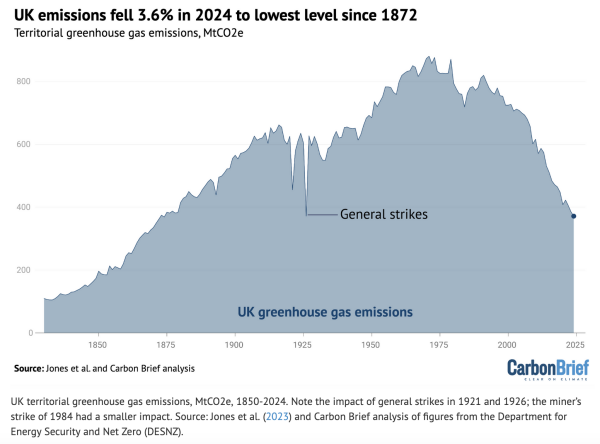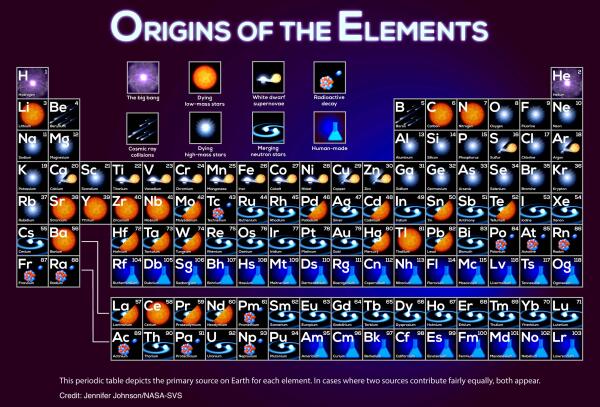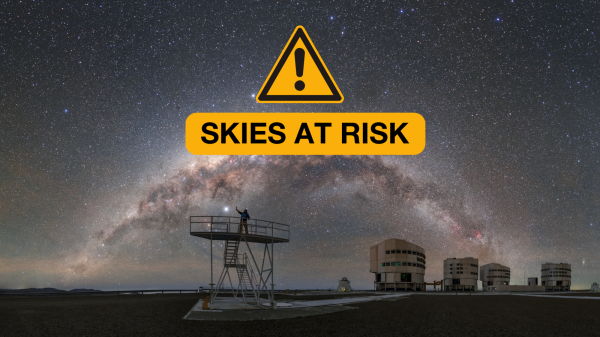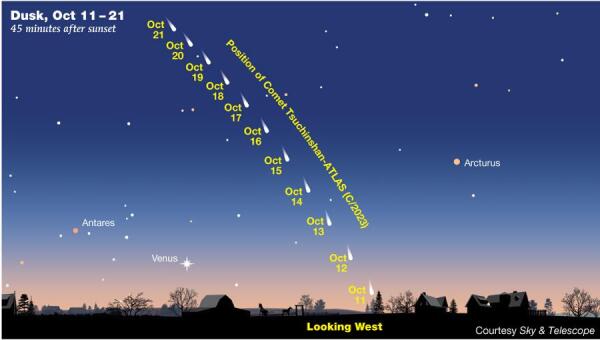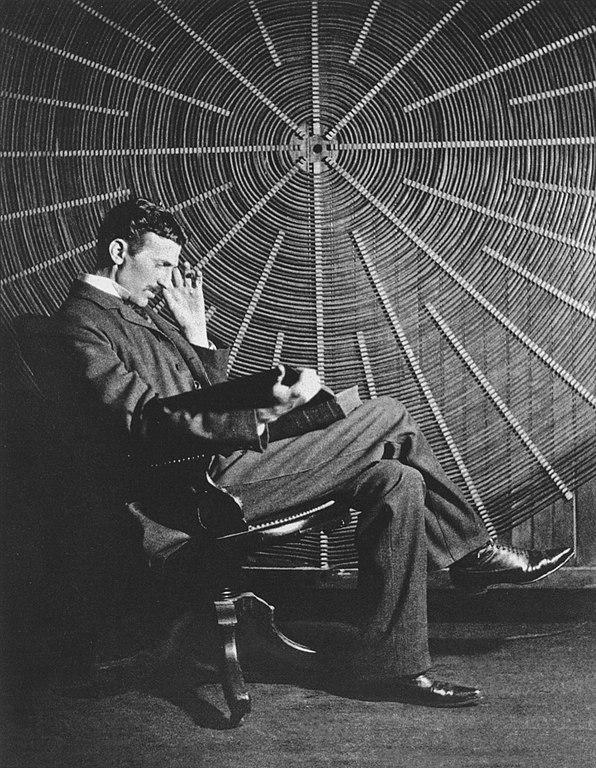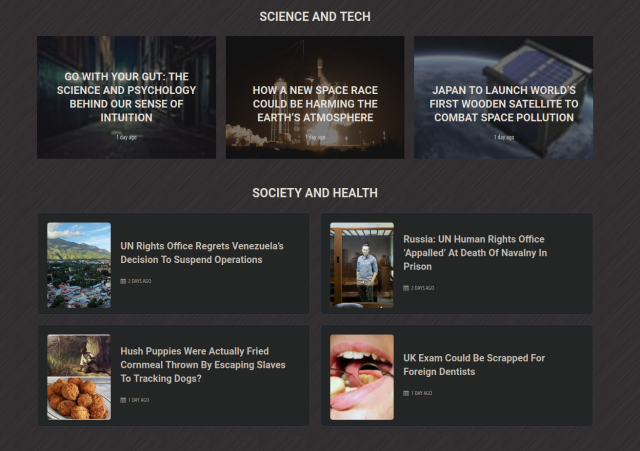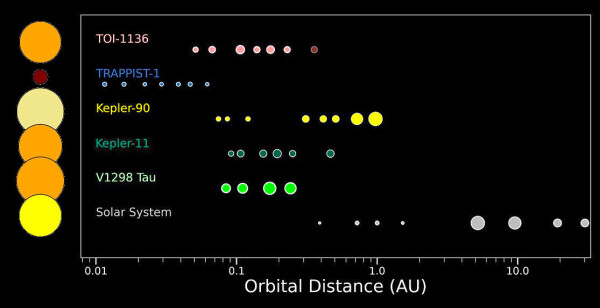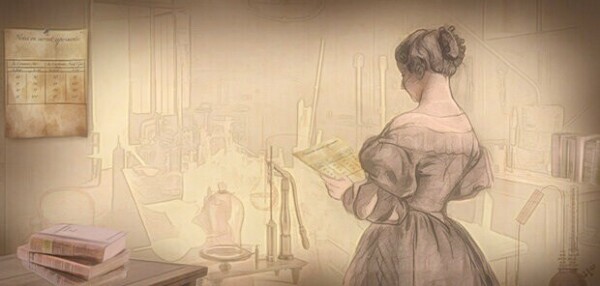Search
Items tagged with: science
Warped Sky: Star Trails over Arches National Park
* Image Credit & Copyright: Vincent Brady
Explanation:
What's happened to the sky? A time warp, of sorts, and a digital space warp too. The time warp occurs because this image captured in a single frame a two and a half hour exposure of the night sky. As a result, prominent star trails are visible. The space warp occurs because the picture is actually a full 360 degree panorama, horizontally compressed to fit your browser. As the Earth rotated, stars appeared to circle both the North Celestial Pole, on the left, and the South Celestial Pole, just below the horizon on the right. The above panorama over Arches National Park in Utah, USA, was captured two weeks ago during early morning hours. While the eye-catching texture of ancient layered sandstone covers the image foreground, twenty-meter tall Delicate Arch is visible on the far right, and the distant arch of our Milky Way Galaxy is visible near the image center.
https://apod.nasa.gov/apod/ap140317.html
#space #earth #astrophotography #photography #astroart #art #science #nature
APOD: 2014 March 17 - Warped Sky: Star Trails over Arches National Park
A different astronomy and space science related image is featured each day, along with a brief explanation.apod.nasa.gov
Little Planet Astro Camp
* Image Credit & Copyright: György Soponyai
Explanation:
Day and night on this little planet look a lot like day and night on planet Earth. In fact, the images used to construct the little planet projection, a digitally warped and stitched mosaic covering 360x180 degrees, were taken during day and night near Tarján, Hungary, planet Earth. They span a successful 33-hour-long photo experiment at July's Hungarian Astronomical Association Astro Camp. The time-series composite follows the solar disk in 20 minute intervals from sunrise to sunset and over six hours of star trails in the northern night sky centered on the North Celestial Pole near bright star Polaris. The orbiting International Space Station traced the offset arc across the northern night. Below the little planet's nightside horizon, red light lamps of fellow astro-campers left the night-long, dancing trails.
https://apod.nasa.gov/apod/ap160902.html
#space #earth #astrophotography #photography #astroart #art #science #nature
APOD: 2016 September 2 - Little Planet Astro Camp
A different astronomy and space science related image is featured each day, along with a brief explanation.apod.nasa.gov
APOD: 2016 October 15 - Gemini Observatory North
A different astronomy and space science related image is featured each day, along with a brief explanation.apod.nasa.gov
APOD: 2017 August 30 - Panoramic Eclipse Composite with Star Trails
A different astronomy and space science related image is featured each day, along with a brief explanation.apod.nasa.gov
Bow Tie Moon and Star Trails
* Image Credit & Copyright: Haitong Yu
Explanation:
On January 31, a leisurely lunar eclipse was enjoyed from all over the night side of planet Earth, the first of three consecutive total eclipses of the Moon. This dramatic time-lapse image followed the celestial performance for over three hours in a combined series of exposures from Hebei Province in Northern China. Fixed to a tripod, the camera records the Full Moon sliding through a clear night sky. Too bright just before and after the eclipse, the Moon's bow tie-shaped trail grows narrow and red during the darker total eclipse phase that lasted an hour and 16 minutes. In the distant background are the colorful trails of stars in concentric arcs above and below the celestial equator.
https://apod.nasa.gov/apod/ap180208.html
#space #earth #astrophotography #photography #astroart #art #science #nature
APOD: 2018 February 8 - Bow Tie Moon and Star Trails
A different astronomy and space science related image is featured each day, along with a brief explanation.apod.nasa.gov
APOD: 2018 July 13 - Star Trails and the Bracewell Radio Sundial
A different astronomy and space science related image is featured each day, along with a brief explanation.apod.nasa.gov
Little Planet Lookout
* Image Credit & Copyright: Gyorgy Soponyai
Explanation:
Don't panic. This little planet projection looks confusing, but it's actually just a digitally warped and stitched, nadir centered mosaic of images that covers nearly 360x180 degrees. The images were taken on the night of October 31 from a 30 meter tall hill-top lookout tower near Tatabanya, Hungary, planet Earth. The laticed lookout tower construction was converted from a local mine elevator. Since planet Earth is rotating, the 126 frames of 75 second long exposures also show warped, concentric star trails with the north celestial pole at the left. Of course at this location the south celestial pole is just right of center but below the the little planet's horizon. the little planet's horizon.
https://apod.nasa.gov/apod/ap181109.html
#space #earth #astrophotography #photography #astroart #art #science #nature
APOD: 2018 November 9 - Little Planet Lookout
A different astronomy and space science related image is featured each day, along with a brief explanation.apod.nasa.gov
Mount Everest Star Trails
* Image Credit & Copyright: Jeff Dai (TWAN)
Explanation:
The highest peak on planet Earth is framed in this mountain and night skyscape. On September 30, the digital stack of 240 sequential exposures made with a camera fixed to a tripod at an Everest Base Camp captured the sheer north face of the Himalayan mountain and foreground illuminated by bright moonlight. Taken over 1.5 hours, the sequence also recorded colorful star trails. Reflecting the planet's daily rotation on its axis, their motion is along gentle concentric arcs centered on the south celestial pole, a point well below the rugged horizon. The color of the trails actually indicates the temperatures of the stars. Blueish hues are from hotter stars, and yellow to reddish hues are from stars cooler than the Sun.
https://apod.nasa.gov/apod/ap181201.html
#space #earth #astrophotography #photography #astroart #art #science #nature
APOD: 2018 December 1 - Mount Everest Star Trails
A different astronomy and space science related image is featured each day, along with a brief explanation.apod.nasa.gov
APOD: 2009 March 14 - Haute-Provence Star Trails
A different astronomy and space science related image is featured each day, along with a brief explanation.apod.nasa.gov
North Celestial Tree
* Image Credit & Copyright: Jerónimo Losada
Explanation:
If you climbed this magnificent tree, it looks like you could reach out and touch the North Celestial Pole at the center of all the star trail arcs. The well-composed image was recorded over a period of nearly 2 hours as a series of 30 second long, consecutive exposures on the night of October 5. The exposures were made with a digital camera fixed to a tripod near Almaden de la Plata, province of Seville, in southern Spain, planet Earth. Of course, the graceful star trails reflect the Earth's daily rotation around its axis. By extension, the axis of rotation leads to the center of the concentric arcs in the night sky. Convenient for northern hemisphere night sky photographers and celestial navigators alike, the bright star Polaris is very close to the North Celestial Pole and so makes the short bright trail in the central gap between the leafy branches.
https://apod.nasa.gov/apod/ap131023.html
#space #earth #astrophotography #photography #astroart #art #science #nature #education
APOD: 2013 October 23 - North Celestial Tree
A different astronomy and space science related image is featured each day, along with a brief explanation.apod.nasa.gov
A Night at Poker Flat
* Image Credit: NASA / Jamie Adkins
Explanation:
Four NASA suborbital sounding rockets leapt into the night on January 26, from the University of Alaska's Poker Flat Research Range. This time lapse composite image follows all four launches of the small, multi-stage rockets to explore winter's mesmerizing, aurora-filled skies. During the exposures, stars trailed around the North Celestial Pole, high above the horizon at the site 30 miles north of Fairbanks, Alaska. Lidar, beams of pulsed green lasers, also left traces through the scene. Operating successfully, the payloads lofted were two Mesosphere-Lower Thermosphere Turbulence Experiments (M-TeX) and two Mesospheric Inversion-layer Stratified Turbulence (MIST) experiments, creating vapor trails at high altitudes to be tracked by ground-based observations.
https://apod.nasa.gov/apod/image/1501/PFlatLaunch_compositeJan26_0.jpg
#space #earth #astrophotography #photography #astroart #art #science #nature #education
The Windmill and the Star Trails
* Image Credit & Copyright: Antonio Gonzalez
Explanation:
Stars can't turn these old wooden arms, but it does look like they might in this scene from a rotating planet. The well-composed night skyscape was recorded from Garafia, a municipality on the island of La Palma, Canary Islands, planet Earth. The center of the once working windmill, retired since 1953, is lined-up with the north celestial pole, the planet's rotation axis projected on to the northern sky. From a camera fixed to a tripod, the star trails are a reflection of the planet's rotation traced in a digital composite of 39 sequential exposures each 25 seconds long. Brought out by highlighting the final exposure in the sequence, the stars themselves appear at the ends of their short concentric arcs. A faint band of winter's Milky Way and even a diffuse glow from our neighboring Andromeda Galaxy also shine in the night.
https://apod.nasa.gov/apod/ap200417.html
#space #earth #astrophotography #photography #astroart #art #science #nature #education
APOD: 2020 April 17 - The Windmill and the Star Trails
A different astronomy and space science related image is featured each day, along with a brief explanation.apod.nasa.gov
North Celestial Aurora
* Image Credit & Copyright: Chirag Upreti
Explanation:
Graceful star trail arcs reflect planet Earth's daily rotation in this colorful night skyscape. To create the timelapse composite, on May 12 consecutive exposures were recorded with a camera fixed to a tripod on the shores of the Ashokan Reservoir, in the Catskills region of New York, USA. North star Polaris is near the center of the star trail arcs. The broad trail of a waxing crescent Moon is on the left, casting a strong reflection across the reservoir waters. With intense solar activity driving recent geomagnetic storms, the colorful aurora borealis or northern lights, rare to the region, shine under Polaris and the north celestial pole.
https://apod.nasa.gov/apod/ap240518.html
#space #earth #astrophotography #photography #astroart #art #science #nature #education
APOD: 2024 May 18 - North Celestial Aurora
A different astronomy and space science related image is featured each day, along with a brief explanation.apod.nasa.gov
Sky Full of Arcs
* Image Credit & Copyright: Rory Gannaway
Explanation:
On August 11 a Rocket Lab Electron rocket launched from a rotating planet. With a small satellite on board its mission was dubbed A Sky Full of SARs (Synthetic Aperture Radar satellites), departing for low Earth orbit from Mahia Peninsula on New Zealand's north island. The fiery trace of the Electron's graceful launch arc is toward the east in this southern sea and skyscape, a composite of 50 consecutive frames taken over 2.5 hours. Fixed to a tripod, the camera was pointing directly at the South Celestial Pole, the extension of planet Earth's axis of rotation in to space. But no bright star marks that location in the southern hemisphere's night sky. Still, the South Celestial Pole is easy to spot. It lies at the center of the concentric star trail arcs that fill the skyward field of view.
https://apod.nasa.gov/apod/ap240817.html
#space #earth #astrophotography #photography #astroart #art #science #nature #education
APOD: 2024 August 17 - Sky Full of Arcs
A different astronomy and space science related image is featured each day, along with a brief explanation.apod.nasa.gov
APOD: 2020 February 12 - Star Trails of the North and South
A different astronomy and space science related image is featured each day, along with a brief explanation.apod.nasa.gov
APOD: 2020 April 7 - A Path North
A different astronomy and space science related image is featured each day, along with a brief explanation.apod.nasa.gov
The news has been more than a bit grim of late, so hooray for Carbon Brief providing some genuine and really meaningful **good** news: the UK's carbon emissions in 2024 were the lowest since 1872, because demand for fossil fuels just keeps decreasing.
#climate #GHG #science #GoodNews
Analysis: UK emissions fall 3.6% in 2024 as coal use drops to lowest since 1666 - Carbon Brief
UK greenhouse gas emissions fell by 3.6% in 2024 as coal use dropped to the lowest level since 1666, the year of the Great Fire of LondonCarbon Brief Staff (Carbon Brief)
You've probably heard that "we are stardust," but this graphic breaks it down further & tells you what kind of stars your dust came from--and which elements didn't come from stars at all.
https://svs.gsfc.nasa.gov/13873/ #science #nature #space
Periodic Table of the Elements: Origins of the Elements
This periodic table depicts the primary source on Earth for each element. In cases where two sources contribute fairly equally, both appear. || PeriodicTableOrigins2_print.jpg (1024x682) [251.7 KB] || PeriodicTableOrigins2_Large.NASA Scientific Visualization Studio
The skies of Chile’s Atacama Desert, renowned as the darkest and clearest of the world, are now at risk from an industrial megaproject.
Electricity company AES Andes proposed to locate a large-scale industrial complex just a few kilometres away from our Paranal Observatory. If constructed, the resulting dust emissions, increased atmospheric turbulence, and especially light #pollution, would irreparably impact the capabilities for astronomical observation.
We urge the involved parties, specifically AES Andes, to work with the Government of #Chile to relocate this megaproject to a zone compatible with industrial development without jeopardising the skies of Paranal.
Read more: https://www.eso.org/public/news/eso2501/?lang
📷 ESO/P. Horálek
#environment #astrodon #astronomy #science
World's darkest and clearest skies at risk from industrial megaproject
On December 24th, AES Andes, a subsidiary of the US power company AES Corporation, submitted a project for a massive industrial complex for environmental impact assessment.www.eso.org
I feel like we could all use some good news right now, so here you go: Bright comet Tsuchinshan-ATLAS will become visible in the evening sky starting tomorrow night.
Clear view to the west essential. Sharp eyes highly recommended. Pointers at the link.
https://skyandtelescope.org/press-releases/bright-comet-evening-view/ #space #science #astronomy #nature #photography
I really love this description of a retracted study: not only does it explain what was retracted (turns out men don't generally divorce their sick wives), but also it covers what the error was (a coding problem treated people who left the study as divorced) how it all went down (someone tried to replicate, asked for data and didn't get the same analysis. Contacted the authors and they were horrified and immediately worked to retract).
It's a really nice story of why replication matters and how to be good at science. This is how I was taught science should work, but I rarely come across such good retrospectives.

“To our horror”: Widely reported study suggesting divorce is more likely when wives fall ill gets axed
A widely reported finding that the risk of divorce increases when wives fall ill — but not when men do — is invalid, thanks to a short string of mistaken coding that negates the origina…Retraction Watch
https://juliaserano.medium.com/gender-affirming-care-for-trans-youth-is-neither-new-nor-experimental-a-timeline-and-compilation-b4bb8375d797 #trans #transgender #LGBTQ #lgbtqia #health #science

Gender-Affirming Care for Trans Youth Is Neither New nor Experimental: A Timeline and Compilation of Studies
NOTE: this essay is a 15 minute read. If it’s listed as longer than that, it’s because it contains a list of over 100 references at the end. Trans and gender-diverse people are a pancultural and…Julia Serano (Medium)
Serbian inventor, electrical engineer, mechanical engineer, and futurist Nikola Tesla was born #OTD in 1856.
Some of Tesla´s inventions and innovations: alternating Current (AC) system; induction motor; Tesla coil; wireless transmission of electricity; radio technology; remote control; neon and fluorescent lighting; X-Ray technology; Tesla turbine; oscillators and frequency generators.
https://en.wikipedia.org/wiki/Nikola_Tesla
Books by Nikola Tesla at PG:
https://www.gutenberg.org/ebooks/author/5067
Books by Tesla, Nikola (sorted by popularity)
Project Gutenberg offers 73,924 free eBooks for Kindle, iPad, Nook, Android, and iPhone.Project Gutenberg

Death, Lonely Death
Billions of miles away at the edge of the Solar System, Voyager 1 has gone mad and has begun to die.Let’s start with the “billions of miles”. Voyager 1 was launched in early Septe…Crooked Timber
Now TROMnews has categories for the news to make it a lot easier to sort through them.
The homepage also got a bit of a rework for the News section:
TROMnews is now far better than it was before. If you'd like to support this work please consider helping us here https://www.tromsite.com/donate/
#tromlive #news #science #environment #climatechange #tech #foss
What is "normal" anyway?
Astronomers have found multi-planet systems around a number of nearby stars, but none that's much like our own. They're not a lot like each other, either.
We still don't know what a normal planetary system looks like, or if there even is such a thing.
https://astrobiology.com/2024/01/unraveling-the-mysteries-of-planet-formation-and-evolution-in-a-distant-solar-system.html #science #nature #astronomy
Unraveling The Mysteries Of Planet Formation And Evolution In A Distant Solar System - Astrobiology
A recently discovered solar system with six confirmed exoplanets and a possible seventh is boosting astronomers’ knowledge of planet formation and evolution.Keith Cowing (Astrobiology)
Unter #UnisinsFediverse versuchen wir möglichst viel öffentlichen Druck aufzubauen, damit die Hochschulen endlich X verlassen und stattdessen die sozialen Medien im #Fediverse nutzen. Teil der Kampagne ist eine Petition:
Jede Unterstützung zählt: Unterschriften, weiterverbreiten, mit Uni-Leitungen reden und sie überzeugen Musk den Rücken zu kehren und das Fediverse zu unterstützen!
It's a brief article - a positive note, generally.
The First-Ever Lunar Farm Shows That Plants Can Grow On The Moon | IFLScience • https://www.iflscience.com/the-first-ever-lunar-farm-shows-that-plants-can-grow-on-the-moon-71370?utm_source=digg
#science #agriculture #sf #moon #china #plants #botany
The First-Ever Lunar Farm Shows That Plants Can Grow On The Moon
Low gravity has benefits, it seems, including increased cold resistance.Stephen Luntz (IFLScience)
The Siena Galaxy Atlas contains the most precise overview of galaxies in the nearby universe: 380,000 of them, each one as vast and storied as our own Milky Way. https://noirlab.edu/public/news/noirlab2328/
#space #science #astronomy
New Siena Galaxy Atlas Delivers Improved Measurements of Almost 400,000 Nearby Galaxies - The unprecedented digital atlas includes data from NOIRLab telescopes and will be an invaluable resource for research into galaxy formation and the structure of the
Astronomers have created a detailed atlas of almost 400,000 galaxies in our cosmic neighborhood. The Siena Galaxy Atlas was compiled using data from NSF's NOIRLab telescopes, and is designed to be the pre-eminent digital galaxy atlas for large galaxi…www.noirlab.edu
#Science isn’t “facts.” It isn’t “truth.”
It’s a dynamic process in which we’re always testing hypotheses & learning more about our world.
“Net Zero by 2050" Get the Joke? - Lannie Rose - Medium
We insiders—by which I mean anyone paying attention — know that the plan to mitigate the climate catastrophe with Net Zero by 2050 is complete bullshit. But maybe you’ve absorbed the knowledge…Lannie Rose (Medium)
Physicist John Tyndall is often credited w discovering the greenhouse effect, which he wrote about in 1859.
But Eunice Foote published a paper - 3yrs earlier - demonstrating how atmospheric water vapor & CO2 affected solar heating. She theorized that heat trapping gases in Earth’s atmosphere warm its climate.
Tyndall was widely read. And Foote, being a woman, wasn't even permitted to present her own work. http://www.climate.gov/news-features/features/happy-200th-birthday-eunice-foote-hidden-climate-science-pioneer #history #science #ClimateChange
Happy 200th birthday to Eunice Foote, hidden climate science pioneer
American Eunice Foote was an amateur scientist and women's rights pioneer from the mid-1800s whose experiments foreshadowed the discovery of Earth's greenhouse effect.NOAA Climate.gov
"The discovery of this ceramic water pipe network is remarkable because the people of Pingliangtai were able to build and maintain this advanced water management system with stone age tools and without the organization of a central power structure. This system would have required a significant level of community-wide planning and coordination, and it was all done communally."
https://phys.org/news/2023-08-china-ancient-pipe-networks-communal.html
#goodnews #goodreads #china #science #archeology
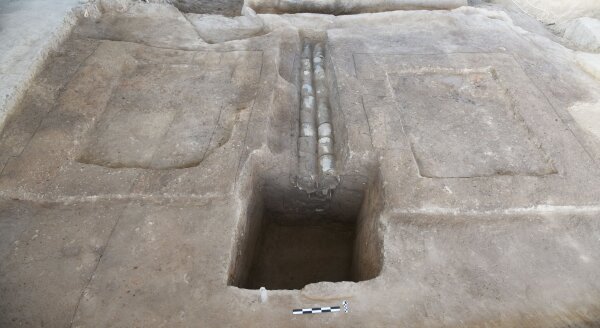
China's ancient water pipe networks show they were a communal effort with no evidence of a centralized state authority
A system of ancient ceramic water pipes, the oldest ever unearthed in China, shows that neolithic people were capable of complex engineering feats without the need for a centralized state authority, finds a new study by University College London rese…Science X (Phys.org)
Wally Broecker divined how the climate could suddenly shift
Wally Broecker’s insight into the shutdown of the great ocean conveyor belt spurred the study of abrupt climate change.Alexandra Witze (Science News Magazine)
